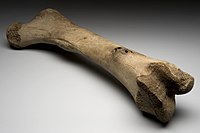
Photo from wikipedia
Purpose: Vitamin D functions to regulate serum calcium concentrations via several cellular pathways. It has also been demonstrated to affect bone mineralization and turnover, thus making it essential for skeletal… Click to show full abstract
Purpose: Vitamin D functions to regulate serum calcium concentrations via several cellular pathways. It has also been demonstrated to affect bone mineralization and turnover, thus making it essential for skeletal strength and adaptation to mechanical stress. Stress fractures are common athletic injuries formed by cyclic, repetitive skeletal loading that causes physical breakdown of the bone’s microstructure. Excessive running or jumping, coinciding with additional factors such as malnutrition or decreased sun exposure, may elevate an athlete’s risk for sustaining this overuse injury. Serum 25(OH)D is used as a clinical marker for vitamin D status. Previous research suggests adequate vitamin D status is important for prevention of skeletal injuries. Our hypothesis states that supplemental vitamin D will normalize athletes’ vitamin D status and will reduce stress fracture injury incidence rates for elite division 1 athletes. Methods: Prospective 245 subjects were recruited from 17 sports teams at the university. All subjects were over 18 years of age. No subjects were excluded. Subject 25(OH)D status was determined twice; once in August 2016, and again in February 2017. Following each testing cycle, subjects with 25(OH)D levels below 70 ng/ml were supplemented with cholecalciferol (50,000 IU) once a week for 8 weeks. Subjects were then monitored throughout their respective sporting seasons for stress fractures or other overuse skeletal injuries. Subjects initially completed an anthropometric questionnaire, and two compliance questionnaires were to be completed following each 8-week supplementation period. Retrospective: Athlete injury reports from each of the 17 teams will be used as a control to determine the incidence of stress fractures during the 2011-2015 seasons among non-supplemented athletes. Results: 245 subjects had 25(OH)D levels tested in August (40.4?14.3 ng/ml) with 18% being insufficient or deficient (<30 ng/ml). 191 subjects were tested in February (27.7?8.85 ng/ml) with 65% being insufficient or deficient, a significant decrease. All but three teams had significantly lower 25(OH)D levels in February compared to August. There was no significant difference between male and female athletes, however both groups saw significant declines in February. There was no significant difference between indoor and outdoor sports in August and February. 2 stress injuries were diagnosed in 118 enrolled subjects in our previous arm (1.65%). 2 additional stress injuries were diagnosed in 191 remaining subjects in our current arm (1.0%). 36 stress fractures were diagnosed in 571 subjects retrospectively (6.3%). Conclusion: Several factors have been shown to influence vitamin D status, including nutrition and sun exposure. Serum 25(OH)D status is expected to decline naturally in winter months due to lack of sun exposure. Results indicate a substantial decline in serum 25(OH)D from August to February in our cohort. This supports the notion that continued supplementation may be necessary to maintain appropriate vitamin D levels. The incidence of stress fractures per year as well as the proportion of stress fractures per academic year have consistently declined as more attention is paid toward vitamin D supplementation.
Journal Title: Orthopaedic Journal of Sports Medicine
Year Published: 2019
Link to full text (if available)
Share on Social Media: Sign Up to like & get
recommendations!